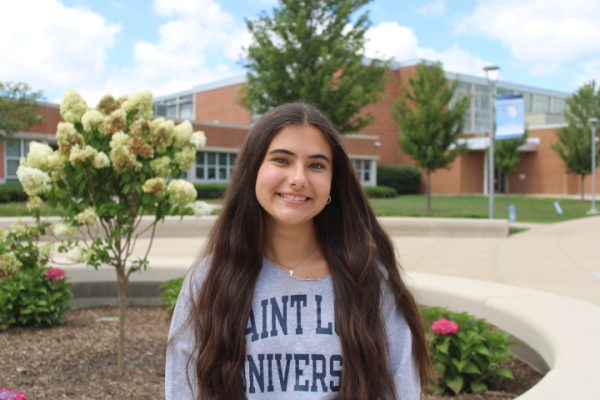Walking through the commons, past the cafeteria and security vestibules, students are faced with large wall art — the key to Prospect’s history. Some might pass right by, not even glancing at the wall, while others take time during their passing periods to gaze at the collage of pictures, taking in the endless timeline of events that have led Prospect to be the school it is today.
What most probably don’t know, though, is that Associate Principal Frank Mirandola spent hours upon hours organizing the plans for the wall, creating the spectacle with historical events he not only researched, but some of which he also experienced himself.
“One of the big questions I was asking myself while creating this wall with not only other teachers, but also with [help from] students, was ‘Is Prospect an accurate microcosm of the American experiences?’” Mirandola said, who started at Prospect in 2002 as a history teacher.
The visual timeline Mirandola created contains an iconic picture that explains one of the main reasons Prospect’s culture and population booms today. The photo of two high school boys, one wearing a red letterman jacket, and the other wearing a blue one signifies the closing of Arlington High School (AHS) in 1984, and its students attending Prospect.
AHS and its many traditions were established in 1922, located where Christian Liberty currently is. When AHS opened, there were roughly 100 students attending. From 1928 to 1980, the school undertook numerous renovations, some following the swell of teenagers in the area due to the baby boom.
Year later, after a regression in the population of Arlington Heights and Mount Prospect, District 214 noticed the number of schools in the district were not needed for the amount of students attending. Two schools had to be closed. AHS and Forest View High School shut down, with the class of 1984 being the last to graduate.
This left the town angry, causing parents to even sue the district. According to Hammerstrom, at first the judge on the case sided with the parents. After careful consideration, though, about the control parents might have in education cases like this in the future (the court didn’t want other school boards around the country getting sued, according to Hammerstrom), the judge dismissed the case and closed AHS for good.
“We don’t know for sure why [AHS] was the one to be closed,” Mirandola said. “If I had to guess, though, it would be because of how old the building was.”
The remaining students of AHS now had a choice. They could attend one of three schools: Prospect, Hersey or Rolling Meadows.
For former English teacher and current security guard Erik Hammerstrom, the choice was simple. Having been a junior when his beloved high school closed, he was determined to finish out his high school career on a high note and have an enjoyable senior year.
“I was standing up in the theater where our class was talking about where we should go to school for our last year,” Hammerstrom said. “I said, ‘Guys, our senior year isn’t over. We could all just go to the same high school.’”
That’s when he made the decision to attend Prospect as a part of the class of 1985. According to Hammerstrom, about 85% of his graduation class moved to Prospect with him.
“There was already really bad blood with Hersey for us [when we attended AHS], so going there wasn’t going to be an option,” Hammerstrom said.
Because both Prospect and AHS had strong rivalries with Hersey, the competition only grew when the schools combined.
“I remember we were really welcomed at Prospect,” Hammerstrom said. He recalled a memory he had of the football team; the first year AHS students arrived at Prospect, the team wore red Ps on their helmets to honor their new students. “I think they really understood what we were going through and they were excited that we had chosen them and wanted to become Knights.”
Prospect’s culture was very important to Hammerstrom when he switched schools, given the fact that he went from a small-town high school to a more populated one.
“One thing that makes Prospect such a special place is the strong culture it holds,” Mirandola said. “[The staff realizes] if you stop building culture with intention, it will fade over time.”















